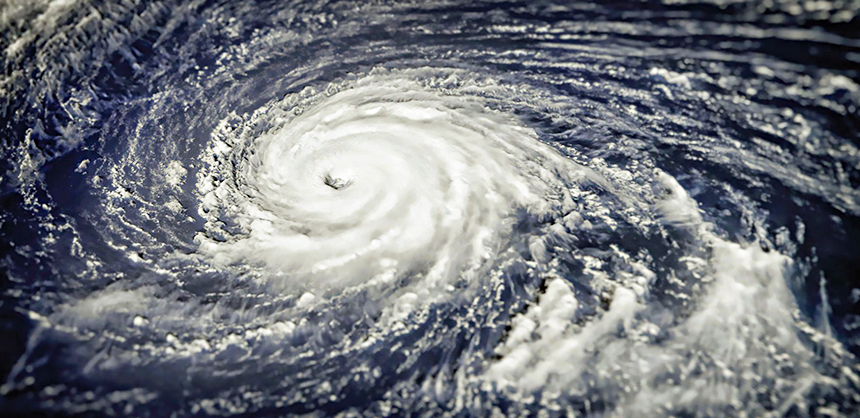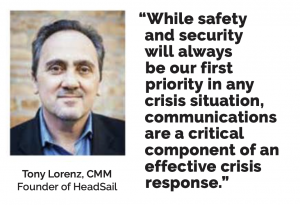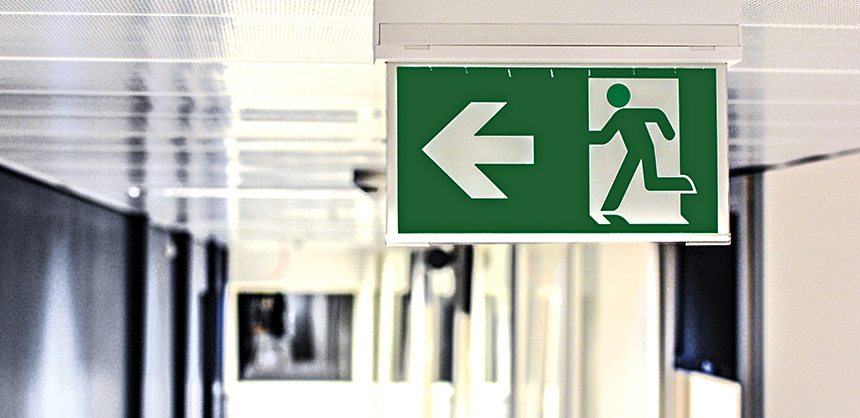Proactive Planning: Tips To Help Planners Weather A CrisisMay 21, 2020
By Christine LoomisProactive Planning: Tips To Help Planners Weather A Crisis

What does it take to be prepared for an emergency?
Meeting planners today have to consider diseases such as COVID-19, natural disasters, weather issues, terrorism, active shooters, and attendee illness or accidents among the possibilities. They have to evaluate risk and have plans to mitigate risks however likely that they may be.
It may cost time and money to be prepared, but it is far more costly to be unprepared if a crisis does arise. So what steps must planners take to feel secure that they are prepared for emergencies and can keep their attendees safe and secure?
Taylor Thomas, CMP, who has worked as a meetings manager, says “Communication, communication, communication! I cannot drive home this point enough. Over communicating with your staff, attendees, vendors, emergency contacts and city-wide partners is beyond crucial when preparing for and dealing with crisis management.”
She points to a weather-related emergency she experienced during an annual conference. “While traveling to one of our client’s annual conferences, we found ourselves right in the ‘path of uncertainty’ of a hurricane. It began as a tropical depression and became a tropical storm a few days prior to the start of our conference. Ultimately, it turned north and missed us, but the immediate need to prepare for a weather catastrophe was at the forefront of that conference,” she says.
Upon arrival, the first thing Thomas and her staff did was conduct a meeting with local city officials, and hotel and convention center partners, to make sure everyone was on the same page regarding information and messaging to send out to attendees, who were already en route to the conference.
“Our first and foremost concern was the safety of our conference attendees,” Taylor says. “We knew anxious attendees would be looking to us for answers, and we wanted to be as equipped as possible to calm their nerves. After carefully going over the information, we prepared a conference update statement, which was sent out to all attendees via e-mail and also passed along to our headquarter call center and hotel front desks to cover all our bases. It’s extremely important not only that the message you put out is factually correct, but also that everyone attending is receiving the same message. The less confusion, the better.”
Within the first few days, when the hurricane’s strength and path was still uncertain, Taylor’s staff worked with volunteer leadership to reschedule sessions and speakers, redesign the exhibit floor and communicate updates with members and attendees.
“As the meeting planner, it was necessary to make sure our emergency plans were up to date with the convention center and hotel, that we had a communication flow plan and that we were aware of necessary evacuation plans if needed,” she says. “We took the time to review our cancellation insurance to make sure we were covered in case the hurricane hit and we had to cancel. Our staff also rented a van at the beginning of the week in case we had to get our staff safely out of harm’s way as well.”
In the end, all was OK. “Even though some of our attendees and members experienced travel frustrations, we overall had a great turnout at our show. And despite 150 last-minute registration cancellations, we ended up having our highest-attended conference in history.”
But just because one event turns out well doesn’t mean preparedness should go by the wayside. Taylor says she had several important takeaways from the experience:
• Prepare ahead of time. Have all emergency contacts for staff, attendees and vendors on hand. Review emergency plans and exit routes upon arrival onsite.
• Purchase cancellation insurance.
• Stock up on necessary supplies and be proactive. That might mean renting a car, purchasing water bottles or getting backup walkie-talkies and batteries for staff. Having these items ready to go if needed will save you time.
• Communicate with everyone. Making sure everyone is on the same page avoids unnecessary confusion and ensures that anxious attendees receive helpful guidance in a stressful situation.
• Remain calm. As the meeting planner, everyone will look to you for guidance and confidence in the crisis.
Crisis Definition
So what exactly constitutes a crisis? Tony Lorenz, CMM, founder of HeadSail, provides an assessment. “We define crisis as any unusual event or disruption that could have a significant negative impact on our business operations, financial performance or brand reputation. A crisis can result in public scrutiny — potentially including media and social media coverage — that can further impact our normal operations.”
Among the most likely scenarios, he says, are data breach/cyber issues, accidents or death involving guests, a security breach at an event and employee misconduct or harassment of guests.
Lorenz says that PRA as an organization is focusing more on crisis management lately. He says, “A crisis can have a ripple effect far beyond PRA’s immediate stakeholders with wide-ranging implications. While safety and security will always be our first priority in any crisis situation, communications are a critical component of an effective crisis response.”
You cannot rely on communications alone to lead the way out of a crisis. He says, “It’s critical to resolve the issue that caused the crisis in the first place.”
That being said, he adds, “Communications considerations are inherently part of every potential crisis situation. And, it is important to be aware of the potential communications’ impact of our actions. Credibility is an organization’s most important ally in a crisis.”
Among the crises he has faced was a participant suffering a heart attack during an incentive program. “He passed away on the scene. We attended to his family first, who were with him at the incentive program, and communicated with the client regularly through the transition. Our communication was swift and, at the same time, discreet given the sensitivity of the family’s loss,” he says.
Considering the range and differences of crises that can occur, to say nothing of the different environments in which they might occur, Lorenz says it’s important to establish guidelines and protocols for different situations.
“We determine the level of severity by three distinct levels, each of which have a defined protocol for response. As a matter of protocol, we review contingency plans in the event of a physical occurrence and identify any areas that need further address, with specificity of the project — participant demographics, location, etc.— as reference points,” he adds.
Moreover, Lorenz says, the PRA crisis communications team “runs across senior teams in critical response functions — IT, internal communications and operations — and is available in all forms of communication, with backup for each member, in the event one of the primary members is completely unavailable.”
And, yet, even the best-laid plans cannot account for all eventualities.

To planners, Lorenz cautions, “Know that, while there are exceptions, it is likely you are not prepared. You should have a framework for response, a mindset as to how to take steps across your organization. No one will attend to a large ‘crisis binder’ in the heat of the moment.”
His top advice for planners and stakeholders is comprised of six steps:
• Assume a “worst-case” position for planning purposes.
• Inform all audiences frequently and accurately from the outset.
• Ensure all responses are candid, accurate and timely.
• Focus on concrete actions being taken to understand and/or address the issue.
• Provide information from the viewpoint of the public, rather than your organization.
• Seek third-party support to communicate and work through the crisis.
Marty MacKay, DMCP, president, Global Alliance, notes that Hosts’ Emergency Preparedness template “is used and tailored by the entire Hosts DMC community, which is comprised of DMCs across more than 300 destinations.”
Like PRA, Hosts Global offices rely on preparation plans that provide a framework for response and can be tailored to different situations.
MacKay says the most likely events to occur are not what most people would consider a true crisis. The most likely events, she says, “usually involve injuries with attendees or attendees getting sick. When people think about crisis and emergency planning, they typically go to the very worst-case scenario. But, really, injuries or even strikes/shuts downs are more likely, and they, too, involve having a plan in place to know proper procedures and protocol.”
Location Matters
MacKay also underscores that, while some crises can occur anywhere — COVID-19, terrorism and attendee accidents, for example — every individual destination has its own potential for certain natural disasters, as well as business continuity plans, which can affect which protocols should be in place during a particular conference or world event.
The truth, however, is that any future crisis is an unknown, as is the impact it might have on a meeting or your business, and that in itself makes it hard for planners to know how to prepare. MacKay recognizes that it’s extremely difficult to plan for the unknown, but stresses that being unprepared could have an even greater negative impact and pose a greater threat.
As our other experts emphasize, MacKay points to communication as one of the most important elements of any crisis plan or protocol. In addition, she adds good planning and training as imperative to any successful blueprint for a crisis. “You have to adequately train your staff and create a clear communication plan that goes into effect in the event of a crisis,” she says.
MacKay also notes that every crisis requires spur-of-the-moment decision-making to ensure the safety of attendees and planning staff. For that reason, training staff and giving them both the knowledge, and authority, to make critical calls during an emergency is imperative.

To be prepared for a crisis, something as simple as coordinating with the venue to be sure attendees know where the emergency exits are is vitally important. Image by monicore from Pixabay
The other element to put front and center is that a planner never has to do this alone. Planners and team leaders must work in concert with event partners, including hotels, venues and other vendors in use during a conference, which provides the ability to share plans and potentially cover any holes one organization may have in its individual plan.
“I like to say that emergency planning is a team sport,” MacKay says. “It is important to involve all your partners and to create open communication. As you work through an event, you should all review each other’s plans and make sure everyone understands which plan you all will follow so you are not operating in a silo. For example, you would follow a venue’s evacuation or shelter plan, and that might integrate with your communication plan to the attendees.”
While communication is recognized as one of the most important elements of crisis planning, MacKay points out that communication processes and protocols are likely to change over time. “Communication during a crisis is an area I see opportunity for in the coming years,” she says. “Most organizations I talk with are reliant on apps in the case of emergencies. However, there is not a 100% adaption rate for all attendees in terms of using these apps. Plus, you need to consider the emergency and cellular/Wi-Fi service. I am seeing more apps being built with the check in safe feature, or other text features, and Twitter being used to push out messaging. Hosts incorporated these features into our app for our event last year and has seen more companies following suit.”
In terms of her best advice for planners to prepare for and mitigate a crisis, MacKay returns to her top-three most important elements of crisis preparedness. “Plan, train and communicate. You can never fully prepare for the unexpected; however, if you have run through almost every scenario that could happen with your team, it will help you make the best decisions should something happen. It will also give you a road map to follow in any situation, based on the protocols you have created,” she says.
There are, of course, dozens and dozens of possible scenarios and situations, from employee illness to something as critical as an active shooter onsite. RANE — Risk Assistance Network + Exchange, an information services and technology company with several East Coast locations — works with organizations on crisis and security plans. “Planners,” RANE’s website notes, “need to be risk-aware and mitigation-minded.”
One of the primary concerns for planners, as RANE points out, is that many of the venues organizations use for their conferences and events, including hotels, sports arenas, theaters, cultural centers and restaurants, have also become soft targets in today’s more volatile world.
To help planners put together solid crisis plans, the company offers a checklist of questions planners should be asking, noting that even these questions don’t cover every single crisis that might occur at a conference or event. Still, planners can use it as a place to start as they create their own crisis and communication plans and protocols. The checklist assumes that risks can come from a variety of situations, and, in the world of best practices, planners must think about even the unthinkable.
Questions to Ponder
• Does the organization or event have a history of receiving threats?
• Have you assessed the potential impact of these threats on the event?
• Has an event timeline been created that identifies critical security tasks for managing administrative and logistical needs?
• Does the event venue have a site security plan?
• Have venue security plans been cross-matched to your organization policy?
• Have you conducted an assessment concerning the need for a professional security firm?
• Has the security plan been communicated and disseminated to key management personnel and departments?
• Does the organization have a written emergency and crisis communication plan?
• Are there adequate and well-marked access and egress paths to and from the event and between areas during the event?
• Has an individual been designated within the organization to coordinate crisis response during the event?
• Have you identified estimated response times to the venue for emergency responders?
• Which hospital has been identified for emergencies?
• Have you determined what numbers and types of medical personnel are needed at the event?
• Have you planned and provided for weather conditions if holding an outdoor event, such as non-slip mats, shade, sunscreen and having drinking water available?
• Have you identified where the public should be sheltered in place or evacuated to in case of a weather emergency?
No one can predict the future, but we can prepare for it. In the event of a crisis, that is what will ultimately keep attendees and planning staff safe and out of harm’s way. AC&F








